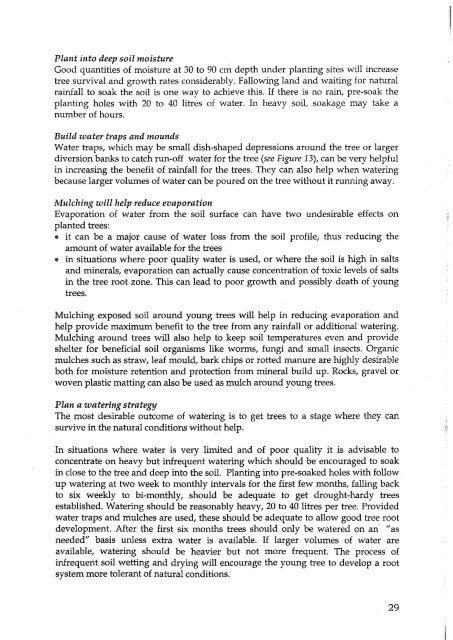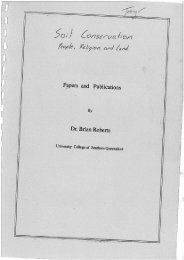western-queensland-gardening-guide.pdf - South West NRM
western-queensland-gardening-guide.pdf - South West NRM
western-queensland-gardening-guide.pdf - South West NRM
Create successful ePaper yourself
Turn your PDF publications into a flip-book with our unique Google optimized e-Paper software.
Plant into deep soil moisture<br />
Good quantities of moisture at 30 to 90 cm depth under planting sites will increase<br />
tree survival and growth rates considerably. Fallowing land and waiting for natural<br />
rainfall to soak the soil is one way to achieve this. If there is no rain, pre-soak the<br />
planting holes with 20 to 40 litres of water. In heavy soil, soakage may take a<br />
number of hours.<br />
Build water traps and mounds<br />
Water traps, which may be small dish-shaped depressions around the tree or larger<br />
diversion banks to catch run-off water for the tree (see Figure 13), can be very helpful<br />
in increasing the benefit of rainfall for the trees. They can also help when watering<br />
because larger volumes of water can be poured on the tree without it running away.<br />
Mulching will help reduce evaporation<br />
Evaporation of water from the soil surface can have two undesirable effects on<br />
planted trees:<br />
it can be a major cause of water loss from the soil profile, thus reducing the<br />
amount of water available for the trees<br />
in situations where poor quality water is used, or where the soil is high in salts<br />
and minerals, evaporation can actually cause concentration of toxic levels of salts<br />
in the tree root zone. This can lead to poor growth and possibly death of young<br />
trees.<br />
Mulching exposed soil around young trees will help in reducing evaporation and<br />
help provide maximum benefit to the tree from any rainfall or additional watering.<br />
Mulching around trees will also help to keep soil temperatures even and provide<br />
shelter for beneficial soil organisms like worms, fungi and small insects. Organic<br />
mulches such as straw, leaf mould, bark chips or rotted manure are highly desirable<br />
both for moisture retention and protection from mineral build up. Rocks, gravel or<br />
woven plastic matting can also be used as mulch around young trees.<br />
Plan a watering stratem<br />
The most desirable outcome of watering is to get trees to a stage where they can<br />
survive in the natural conditions without help.<br />
In situations where water is very limited and of poor quality it is advisable to<br />
concentrate on heavy but infrequent watering which should be encouraged to soak<br />
in close to the tree and deep into the soil. Planting into pre-soaked holes with follow<br />
up watering at two week to monthly intervals for the first few months, falling back<br />
to six weekly to bi-monthly, should be adequate to get drought-hardy trees<br />
established. Watering should be reasonably heavy, 20 to 40 litres per tree. Provided<br />
water traps and mulches are used, these should be adequate to allow good tree root<br />
development. After the first six months trees should only be watered on an "as<br />
needed" basis unless extra water is available. If larger volumes of water are<br />
available, watering should be heavier but not more frequent. The process of<br />
infrequent soil wetting and drying will encourage the young tree to develop a root<br />
system more tolerant of natural conditions.
















